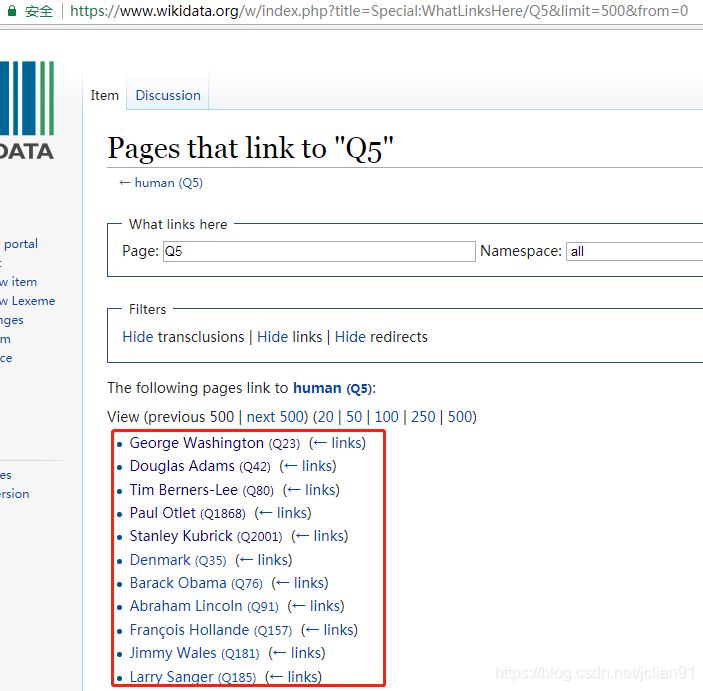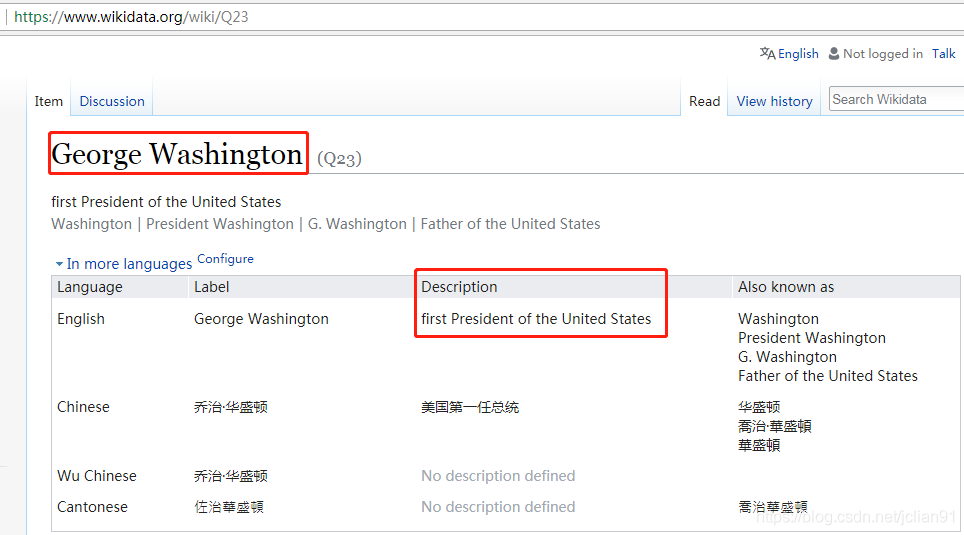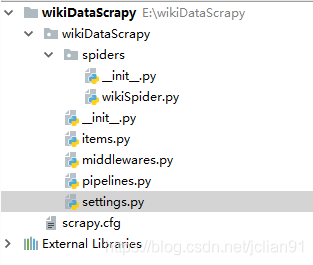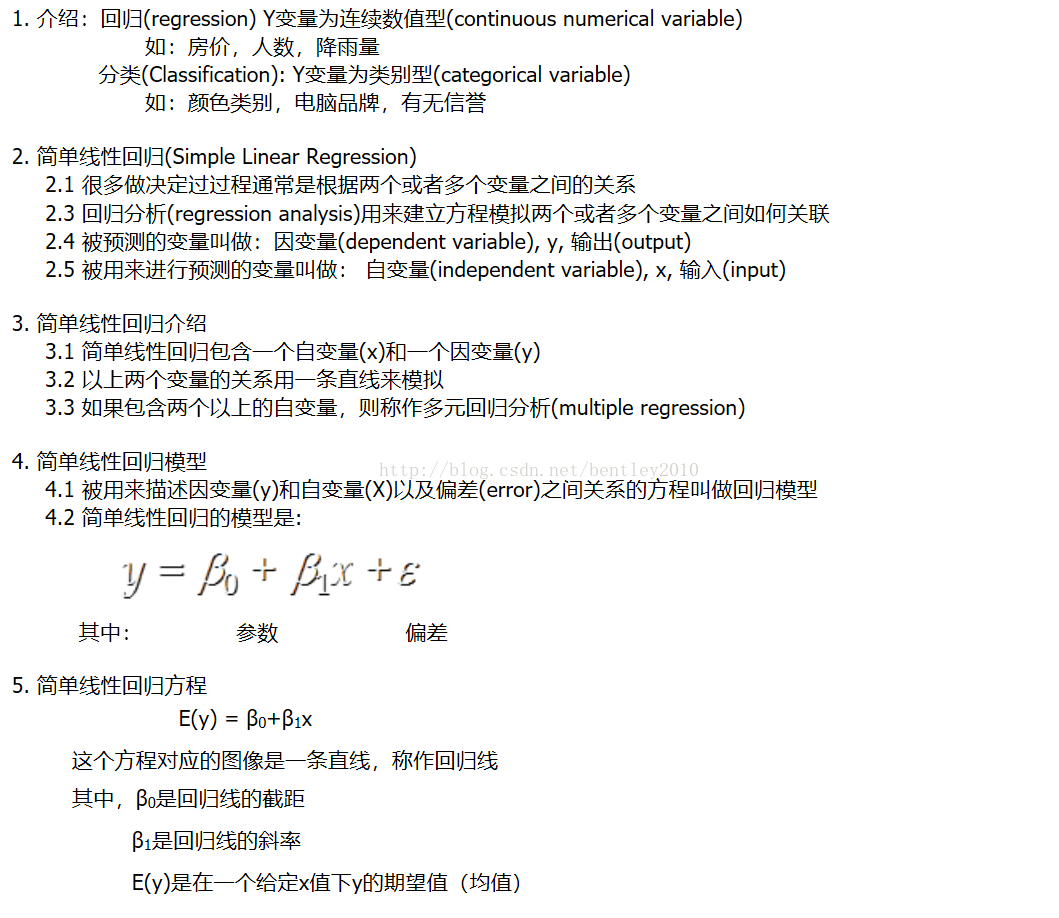问题的由来
前几天,在微信公众号(Python爬虫及算法)上有个人问了笔者一个问题,如何利用爬虫来实现如下的需求,需要爬取的网页如下(网址为:https://www.wikidata.org/w/index.php?title=Special:WhatLinksHere/Q5&limit=500&from=0):
我们的需求为爬取红色框框内的名人(有500条记录,图片只展示了一部分)的 名字以及其介绍,关于其介绍,点击该名人的名字即可,如下图:
这就意味着我们需要爬取500个这样的页面,即500个HTTP请求(暂且这么认为吧),然后需要提取这些网页中的名字和描述,当然有些不是名人,也没有描述,我们可以跳过。最后,这些网页的网址在第一页中的名人后面可以找到,如George Washington的网页后缀为Q23.
爬虫的4种姿势 首先,分析来爬虫的思路:先在第一个网页(https://www.wikidata.org/w/index.php?title=Special:WhatLinksHere/Q5&limit=500&from=0)中得到500个名人所在的网址,接下来就爬取这500个网页中的名人的名字及描述,如无描述,则跳过。
一般方法(同步,requests+BeautifulSoup)
并发(使用concurrent.futures模块以及requests+BeautifulSoup)
异步(使用aiohttp+asyncio+requests+BeautifulSoup)
使用框架Scrapy
一般方法 一般方法即为同步方法,主要使用requests+BeautifulSoup,按顺序执行。完整的Python代码如下:
1 2 3 4 5 6 7 8 9 10 11 12 13 14 15 16 17 18 19 20 21 22 23 24 25 26 27 28 29 30 31 32 33 34 35 36 37 38 39 40 41 42 import requestsfrom bs4 import BeautifulSoupimport timet1 = time.time() print('#' * 50 ) url = "http://www.wikidata.org/w/index.php?title=Special:WhatLinksHere/Q5&limit=500&from=0" headers = {'User-Agent' : 'Mozilla/5.0 (Windows NT 10.0; WOW64) AppleWebKit/537.36 (KHTML, like Gecko) Chrome/67.0.3396.87 Safari/537.36' } req = requests.get(url, headers=headers) soup = BeautifulSoup(req.text, "lxml" ) human_list = soup.find(id ='mw-whatlinkshere-list' )('li' ) urls = [] for human in human_list: url = human.find('a' )['href' ] urls.append('https://www.wikidata.org' +url) def parser (url ): req = requests.get(url) soup = BeautifulSoup(req.text, "lxml" ) name = soup.find('span' , class_="wikibase-title-label" ) desc = soup.find('span' , class_="wikibase-descriptionview-text" ) if name is not None and desc is not None : print('%-40s,\t%s' %(name.text, desc.text)) for url in urls: parser(url) t2 = time.time() print('一般方法,总共耗时:%s' % (t2 - t1)) print('#' * 50 ) 1234567891011121314151617181920212223242526272829303132333435363738394041
输出的结果如下(省略中间的输出,以…代替):
1 2 3 4 5 6 7 8 9 ################################################## George Washington , first President of the United States Douglas Adams , British author and humorist (1952–2001) ...... Willoughby Newton , Politician from Virginia, USA Mack Wilberg , American conductor 一般方法,总共耗时:724.9654655456543 ################################################## 12345678
使用同步方法,总耗时约725秒,即12分钟多。
并发方法 并发方法使用多线程来加速一般方法,我们使用的并发模块为concurrent.futures模块,设置多线程的个数为20个(实际不一定能达到,视计算机而定)。完整的Python代码如下:
1 2 3 4 5 6 7 8 9 10 11 12 13 14 15 16 17 18 19 20 21 22 23 24 25 26 27 28 29 30 31 32 33 34 35 36 37 38 39 40 41 42 43 44 45 46 47 import requestsfrom bs4 import BeautifulSoupimport timefrom concurrent.futures import ThreadPoolExecutor, wait, ALL_COMPLETEDt1 = time.time() print('#' * 50 ) url = "http://www.wikidata.org/w/index.php?title=Special:WhatLinksHere/Q5&limit=500&from=0" headers = {'User-Agent' : 'Mozilla/5.0 (Windows NT 10.0; WOW64) AppleWebKit/537.36 (KHTML, like Gecko) Chrome/67.0.3396.87 Safari/537.36' } req = requests.get(url, headers=headers) soup = BeautifulSoup(req.text, "lxml" ) human_list = soup.find(id ='mw-whatlinkshere-list' )('li' ) urls = [] for human in human_list: url = human.find('a' )['href' ] urls.append('https://www.wikidata.org' +url) def parser (url ): req = requests.get(url) soup = BeautifulSoup(req.text, "lxml" ) name = soup.find('span' , class_="wikibase-title-label" ) desc = soup.find('span' , class_="wikibase-descriptionview-text" ) if name is not None and desc is not None : print('%-40s,\t%s' %(name.text, desc.text)) executor = ThreadPoolExecutor(max_workers=20 ) future_tasks = [executor.submit(parser, url) for url in urls] wait(future_tasks, return_when=ALL_COMPLETED) t2 = time.time() print('并发方法,总共耗时:%s' % (t2 - t1)) print('#' * 50 ) 12345678910111213141516171819202122232425262728293031323334353637383940414243444546
输出的结果如下(省略中间的输出,以…代替):
1 2 3 4 5 6 7 8 9 ################################################## Larry Sanger , American former professor, co-founder of Wikipedia, founder of Citizendium and other projects Ken Jennings , American game show contestant and writer ...... Antoine de Saint-Exupery , French writer and aviator Michael Jackson , American singer, songwriter and dancer 并发方法,总共耗时:226.7499692440033 ################################################## 12345678
使用多线程并发后的爬虫执行时间约为227秒,大概是一般方法的三分之一的时间,速度有了明显的提升啊!多线程在速度上有明显提升,但执行的网页顺序是无序的,在线程的切换上开销也比较大,线程越多,开销越大。Python爬虫之多线程下载豆瓣Top250电影图片 。
异步方法 异步方法在爬虫中是有效的速度提升手段,使用aiohttp可以异步地处理HTTP请求,使用asyncio可以实现异步IO,需要注意的是,aiohttp只支持3.5.3以后的Python版本。使用异步方法实现该爬虫的完整Python代码如下:
1 2 3 4 5 6 7 8 9 10 11 12 13 14 15 16 17 18 19 20 21 22 23 24 25 26 27 28 29 30 31 32 33 34 35 36 37 38 39 40 41 42 43 44 45 46 47 48 49 50 51 52 53 54 55 56 57 58 59 60 import requestsfrom bs4 import BeautifulSoupimport timeimport aiohttpimport asynciot1 = time.time() print('#' * 50 ) url = "http://www.wikidata.org/w/index.php?title=Special:WhatLinksHere/Q5&limit=500&from=0" headers = {'User-Agent' : 'Mozilla/5.0 (Windows NT 10.0; WOW64) AppleWebKit/537.36 (KHTML, like Gecko) Chrome/67.0.3396.87 Safari/537.36' } req = requests.get(url, headers=headers) soup = BeautifulSoup(req.text, "lxml" ) human_list = soup.find(id ='mw-whatlinkshere-list' )('li' ) urls = [] for human in human_list: url = human.find('a' )['href' ] urls.append('https://www.wikidata.org' +url) async def fetch (session, url ): async with session.get(url) as response: return await response.text() async def parser (html ): soup = BeautifulSoup(html, "lxml" ) name = soup.find('span' , class_="wikibase-title-label" ) desc = soup.find('span' , class_="wikibase-descriptionview-text" ) if name is not None and desc is not None : print('%-40s,\t%s' %(name.text, desc.text)) async def download (url ): async with aiohttp.ClientSession() as session: try : html = await fetch(session, url) await parser(html) except Exception as err: print(err) loop = asyncio.get_event_loop() tasks = [asyncio.ensure_future(download(url)) for url in urls] tasks = asyncio.gather(*tasks) loop.run_until_complete(tasks) t2 = time.time() print('使用异步,总共耗时:%s' % (t2 - t1)) print('#' * 50 ) 1234567891011121314151617181920212223242526272829303132333435363738394041424344454647484950515253545556575859
输出结果如下(省略中间的输出,以…代替):
1 2 3 4 5 6 7 8 9 ################################################## Frédéric Taddeï , French journalist and TV host Gabriel Gonzáles Videla , Chilean politician ...... Denmark , sovereign state and Scandinavian country in northern Europe Usain Bolt , Jamaican sprinter and soccer player 使用异步,总共耗时:126.9002583026886 ################################################## 12345678
显然,异步方法使用了异步和并发两种提速方法,自然在速度有明显提升,大约为一般方法的六分之一。异步方法虽然效率高,但需要掌握异步编程,这需要学习一段时间。利用aiohttp实现异步爬虫 。
1 2 3 4 5 6 7 8 9 10 11 12 13 14 15 16 17 18 19 20 21 22 23 24 25 26 27 28 29 30 31 32 33 34 35 36 37 38 39 40 41 42 43 44 45 46 47 48 49 50 51 52 53 54 55 56 57 58 59 60 61 62 import requestsfrom bs4 import BeautifulSoupimport timeimport aiohttpimport asyncioimport ret1 = time.time() print('#' * 50 ) url = "http://www.wikidata.org/w/index.php?title=Special:WhatLinksHere/Q5&limit=500&from=0" headers = { 'User-Agent' : 'Mozilla/5.0 (Windows NT 10.0; WOW64) AppleWebKit/537.36 (KHTML, like Gecko) Chrome/67.0.3396.87 Safari/537.36' } req = requests.get(url, headers=headers) soup = BeautifulSoup(req.text, "lxml" ) human_list = soup.find(id ='mw-whatlinkshere-list' )('li' ) urls = [] for human in human_list: url = human.find('a' )['href' ] urls.append('https://www.wikidata.org' + url) async def fetch (session, url ): async with session.get(url) as response: return await response.text() async def parser (html ): try : name = re.findall(r'<span class="wikibase-title-label">(.+?)</span>' , html)[0 ] desc = re.findall(r'<span class="wikibase-descriptionview-text">(.+?)</span>' , html)[0 ] print('%-40s,\t%s' % (name, desc)) except Exception as err: pass async def download (url ): async with aiohttp.ClientSession() as session: try : html = await fetch(session, url) await parser(html) except Exception as err: print(err) loop = asyncio.get_event_loop() tasks = [asyncio.ensure_future(download(url)) for url in urls] tasks = asyncio.gather(*tasks) loop.run_until_complete(tasks) t2 = time.time() print('使用异步(正则表达式),总共耗时:%s' % (t2 - t1)) print('#' * 50 ) 12345678910111213141516171819202122232425262728293031323334353637383940414243444546474849505152535455565758596061
输出的结果如下(省略中间的输出,以…代替):
1 2 3 4 5 6 7 8 9 ################################################## Dejen Gebremeskel , Ethiopian long-distance runner Erik Kynard , American high jumper ...... Buzz Aldrin , American astronaut Egon Krenz , former General Secretary of the Socialist Unity Party of East Germany 使用异步(正则表达式),总共耗时:16.521944999694824 ################################################## 12345678
16.5秒,仅仅为一般方法的43分之一,速度如此之快,令人咋舌(感谢某人提供的尝试)。笔者虽然自己实现了异步方法,但用的是BeautifulSoup来解析网页,耗时127秒,没想到使用正则表达式就取得了如此惊人的效果。可见,BeautifulSoup解析网页虽然快,但在异步方法中,还是限制了速度。但这种方法的缺点为,当你需要爬取的内容比较复杂时,一般的正则表达式就难以胜任了,需要另想办法。
爬虫框架Scrapy 最后,我们使用著名的Python爬虫框架Scrapy来解决这个爬虫。我们创建的爬虫项目为wikiDataScrapy,项目结构如下:
在settings.py中设置“ROBOTSTXT_OBEY = False”. 修改items.py ,代码如下:
1 2 3 4 5 6 7 8 9 import scrapyclass WikidatascrapyItem (scrapy.Item ): name = scrapy.Field() desc = scrapy.Field() 12345678
然后,在spiders文件夹下新建wikiSpider.py ,代码如下:
1 2 3 4 5 6 7 8 9 10 11 12 13 14 15 16 17 18 19 20 21 22 23 24 25 26 27 28 29 30 31 32 33 34 35 36 37 38 39 40 41 42 43 import scrapy.cmdlinefrom wikiDataScrapy.items import WikidatascrapyItemimport requestsfrom bs4 import BeautifulSoupdef get_urls (): url = "http://www.wikidata.org/w/index.php?title=Special:WhatLinksHere/Q5&limit=500&from=0" headers = { 'User-Agent' : 'Mozilla/5.0 (Windows NT 10.0; WOW64) AppleWebKit/537.36 (KHTML, like Gecko) Chrome/67.0.3396.87 Safari/537.36' } req = requests.get(url, headers=headers) soup = BeautifulSoup(req.text, "lxml" ) human_list = soup.find(id ='mw-whatlinkshere-list' )('li' ) urls = [] for human in human_list: url = human.find('a' )['href' ] urls.append('https://www.wikidata.org' + url) return urls class bookSpider (scrapy.Spider ): name = 'wikiScrapy' start_urls = get_urls() def parse (self, response ): item = WikidatascrapyItem() item['name' ] = response.css('span.wikibase-title-label' ).xpath('text()' ).extract_first() item['desc' ] = response.css('span.wikibase-descriptionview-text' ).xpath('text()' ).extract_first() yield item scrapy.cmdline.execute(['scrapy' , 'crawl' , 'wikiScrapy' , '-o' , 'wiki.csv' , '-t' , 'csv' ]) 123456789101112131415161718192021222324252627282930313233343536373839404142
输出结果如下(只包含最后的Scrapy信息总结部分):
1 2 3 4 5 6 7 8 9 10 11 12 13 14 15 16 17 18 {'downloader/request_bytes': 166187, 'downloader/request_count': 500, 'downloader/request_method_count/GET': 500, 'downloader/response_bytes': 18988798, 'downloader/response_count': 500, 'downloader/response_status_count/200': 500, 'finish_reason': 'finished', 'finish_time': datetime.datetime(2018, 10, 16, 9, 49, 15, 761487), 'item_scraped_count': 500, 'log_count/DEBUG': 1001, 'log_count/INFO': 8, 'response_received_count': 500, 'scheduler/dequeued': 500, 'scheduler/dequeued/memory': 500, 'scheduler/enqueued': 500, 'scheduler/enqueued/memory': 500, 'start_time': datetime.datetime(2018, 10, 16, 9, 48, 44, 58673)} 1234567891011121314151617
可以看到,已成功爬取500个网页,耗时31秒,速度也相当OK。再来看一下生成的wiki.csv文件,它包含了所有的输出的name和description,如下图:
可以看到,输出的CSV文件的列并不是有序的。至于如何解决Scrapy输出的CSV文件有换行的问题 ,请参考stackoverflow上的回答:https://stackoverflow.com/questions/39477662/scrapy-csv-file-has-uniform-empty-rows/43394566#43394566 。
Scrapy来制作爬虫的优势在于它是一个成熟的爬虫框架,支持异步,并发,容错性较好(比如本代码中就没有处理找不到name和description的情形),但如果需要频繁地修改中间件,则还是自己写个爬虫比较好,而且它在速度上没有超过我们自己写的异步爬虫,至于能自动导出CSV文件这个功能,还是相当实在的。
总结 本文内容较多,比较了4种爬虫方法,每种方法都有自己的利弊,已在之前的陈述中给出,当然,在实际的问题中,并不是用的工具或方法越高级就越好,具体问题具体分析嘛~











